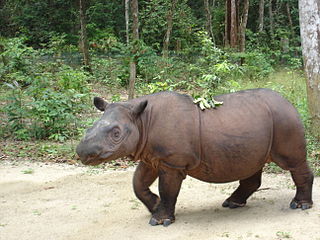
The Sumatran rhinoceros, also known as the Sumatran rhino, hairy rhinoceros or Asian two-horned rhinoceros, is a rare member of the family Rhinocerotidae and one of five extant species of rhinoceros; it is the only extant species of the genus Dicerorhinus. It is the smallest rhinoceros, although it is still a large mammal; it stands 112–145 cm (44–57 in) high at the shoulder, with a head-and-body length of 2.36–3.18 m and a tail of 35–70 cm (14–28 in). The weight is reported to range from 500–1,000 kg (1,100–2,200 lb), averaging 700–800 kg (1,540–1,760 lb). Like both African species, it has two horns; the larger is the nasal horn, typically 15–25 cm (5.9–9.8 in), while the other horn is typically a stub. A coat of reddish-brown hair covers most of the Sumatran rhino's body.

The banteng, also known as tembadau, is a species of cattle found in Southeast Asia. The head-and-body length is between 1.9 and 3.68 m. Wild banteng are typically larger and heavier than their domesticated counterparts, but are otherwise similar in appearance. The banteng shows extensive sexual dimorphism; adult bulls are generally dark brown to black, larger and more sturdily built than adult cows, which are thinner and usually pale brown or chestnut red. There is a big white patch on the rump. Horns are present on both sexes, and are typically 60 to 95 cm long. Three subspecies are generally recognised.
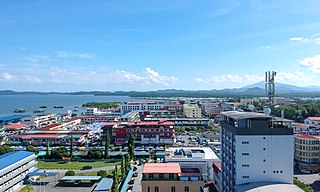
Lahad Datu is the capital of the Lahad Datu District in the Dent Peninsula on Tawau Division of Sabah, Malaysia. Its population was estimated to be around 27,887 in 2010. The town is surrounded by stretches of cocoa and palm oil plantations. It is also an important timber exporting port. The town has an airport for domestic flights.

Danum Valley Conservation Area is a 438 square kilometres tract of relatively undisturbed lowland dipterocarp forest in Sabah, Malaysia. It has an extensive diversity of tropical flora and fauna, including such species as the rare Bornean orangutans, gibbons, mousedeer, clouded leopards and over 270 bird species. Activities offered are jungle treks, river swimming, bird watching, night jungle tours and excursions to nearby logging sites and timber mills.
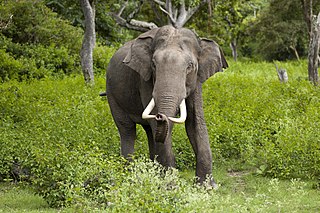
The Indian elephant is one of three extant recognised subspecies of the Asian elephant and native to mainland Asia.

The Borneo elephant, also called the Bornean elephant or the Borneo pygmy elephant, is a subspecies of Asian elephant (Elephas maximus) that inhabits northeastern Borneo, in Indonesia and Malaysia. Its origin remains the subject of debate. A definitive subspecific classification as Elephas maximus borneensis awaits a detailed range-wide morphometric and genetic study. Since 1986, the Asian elephant has been listed as Endangered on the IUCN Red List as the population has declined by at least 50% over the last three generations, estimated to be 60–75 years. It is pre-eminently threatened by loss, degradation and fragmentation of habitat.

The Sunda clouded leopard is a medium-sized wild cat native to Borneo and Sumatra. It is listed as Vulnerable on the IUCN Red List since 2015, as the total effective population probably consists of fewer than 10,000 mature individuals, with a decreasing population trend. On both Sunda Islands, it is threatened by deforestation. It was classified as a separate species, distinct from the clouded leopard in mainland Southeast Asia based on a study in 2006. Its fur is darker with a smaller cloud pattern.

The wildlife of Malaysia is diverse, with Malaysia being a megadiverse country. Most of the country is covered in rainforest, which hosts a huge diversity of plant and animal species. There are approximately 361 mammal species, 694 bird species, 250 reptile species, and 150 frog species found in Malaysia. Its large marine territory also holds a great diversity of life, with the country's coastal waters comprising part of the Coral Triangle.

The Borneo lowland rain forests is an ecoregion, within the tropical and subtropical moist broadleaf forests biome, of the large island of Borneo in Southeast Asia. It supports approximately 15,000 plant species, 380 bird species and several mammal species. The Borneo lowland rain forests is diminishing due to logging, hunting and conversion to commercial land use.

The environment of Malaysia is the biotas and geologies that constitute the natural environment of Malaysia. Malaysia's ecology is megadiverse, with a biodiverse range of flora and fauna found in various ecoregions throughout the country. Tropical rainforests encompass between 59% and 70% of Malaysia's total land area, of which 11.6% is pristine. Malaysia has the world's fifth largest mangrove area, which totals over a half a million hectares.
The Barandabhar forest covers an area of 87.9 km2 and bisects the Chitwan District in east and west Chitwan. Barandabhar, a 29 km long forest patch, is bisected by the Mahendra Highway, resulting in a 56.9 km2 area in the buffer zone of RCNP and 31 km2 is under the district forest office.
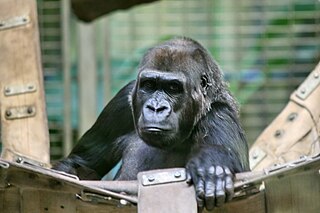
The wildlife of the Central African Republic is in the vast natural habitat in the Central African Republic (CAR) located between the Congo Basin's rain forests and large savannas, where the human density was smaller than 0.5 per km2 prior to 1850. The forest area of 22.755 million, considered one of the richest storehouses of wildlife spread over national parks, hunting reserves and community hunting areas, experienced an alarming loss of wildlife because of greed for ivory and bushmeat exploitation by hunters – mostly Arab slavers from across the borders of the Central African Republic with Chad and Sudan.
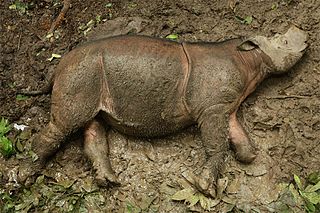
The Bornean rhinoceros, also known as the eastern Sumatran rhinoceros or eastern hairy rhinoceros, is one of three subspecies of Sumatran rhinoceros. The subspecies may be functionally extinct, with only one individual, a female named Pahu, surviving in captivity, and held in the state of Sabah. In April 2015, the Malaysian government declared the Bornean rhinoceros to be extinct in the wild in the Malaysian portion of Borneo. However, in March 2016, a young female rhino was captured in East Kalimantan, providing evidence of their continued existence. The International Union for Conservation of Nature (IUCN) classifies the subspecies as critically endangered.

Many species are affected by poaching, including illegal hunting, fishing and capturing of wild animals, and, in a recent usage, the illegal harvesting of wild plant species. The article provides an overview of species currently endangered or impaired by poaching in the Americas, sub-Saharan Africa, and South-East Asia.

The Lahad Datu District is an administrative district in the Malaysian state of Sabah, part of the Tawau Division which includes the districts of Kunak, Lahad Datu, Semporna and Tawau. The capital of the district is in Lahad Datu Town.
The Dent Peninsula is a peninsula in eastern Sabah, Malaysia. It consists of hills and broad coastal areas. The Peninsula is also previously considered as a volcanic arc of the region which have since migrated southward to Semporna Peninsula.

Hala-Bala Wildlife Sanctuary is a wildlife sanctuary in Thailand, considered to be one of the richest forests of Thailand in the southernmost part of the country. It is dubbed "Amazon of Asean". It was officially established in 1996. Its area is about 270,725 rais which covers the area of Titiwangsa Range and is adjacent to Belum-Temengor Reserve of Malaysia.

Mount Silam is a mountain in Lahad Datu District, Sabah, Malaysia.
Tawai Forest Reserve is a protected forest reserve in Telupid District of Sandakan Division, Sabah, Malaysia. It was first created in January 1972, before being designated as a Class 1 Protection Forest by the Sabah Forestry Department in 1984. It was fully demarcated in 2002, resulting in an area of 22,697 hectares (226.97 km2). The reserve is mostly mountainous, consisting of ultramafic forest, upland mixed dipterocarp forest and kerangas forest. Mount Tawai, at 1,273 metres (4,177 ft), is within the reserve. It is flattest near its northern and eastern edges. The Tawai waterfall is located within the reserve, part of the many rivers which flow through it. Protection of these headwaters was part of the reason for the reserve's establishment. The reserve has been badly affected by fires that have spread into the reserve from nearby settlements and palm oil plantations. Illegal logging has occurred in areas of dipterocarp forest. Illegal logging and land clearance has occurred in some portions of the reserve. There are plans for the Pan-Borneo Highway to be expanded in part through the northern portion of the reserve. The forestry department runs a Rainforest Camp to generate tourism money, providing access to the clean river water of the reserve, rainforest treks, and a waystop near the path of the Sandakan Death Marches.

















